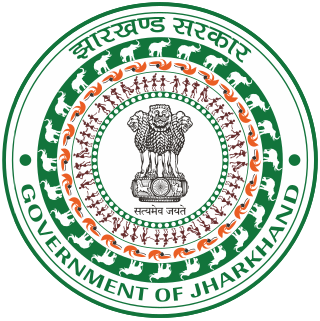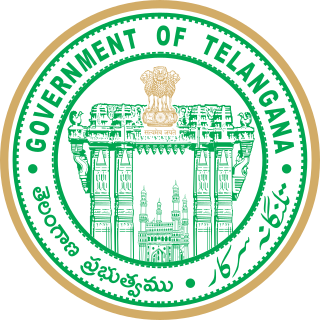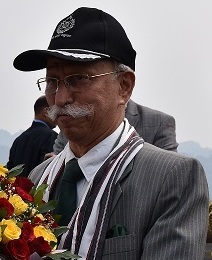
Arunachal Pradesh is a state in northeast India. It was formed from the North-East Frontier Agency (NEFA) region, and India declared it as a state on 20 February 1987. Itanagar is its capital and largest town. It borders the Indian states of Assam and Nagaland to the south. It shares international borders with Bhutan in the west, Myanmar in the east, and a disputed 1,129 km border with China's Tibet Autonomous Region in the north at the McMahon Line. Arunachal Pradesh is claimed by China as part of the Tibet Autonomous Region; China occupied some regions of Arunachal Pradesh in 1962 but later withdrew its forces.

Shankar Dayal Sharma was an Indian lawyer and politician from the state of Madhya Pradesh who served as the ninth president of India, from 1992 to 1997.
In India, President's rule is the suspension of state government and imposition of direct Union government rule in a state. Under Article 356 of the Constitution of India, if a state government is unable to function according to Constitutional provisions, the Union government can take direct control of the state machinery. Subsequently, executive authority is exercised through the centrally appointed governor, who has the authority to appoint other administrators to assist them. The administrators are usually nonpartisan retired civil servants not native to the state.
In India, a governor is the constitutional head of a state of India that has similar powers and functions at the state level as those of the president of India at the central level. Governors exist in the states, while lieutenant governors and administrators exist in union territories of Delhi and Puducherry and other union territories. A governor acts as the constitutional head and takes all their decisions based on the advice of chief minister and their council of ministers.

Shilendra Kumar Singh or S.K. Singh was an Indian diplomat. He was Governor of Arunachal Pradesh from December 2004 to September 2007 and Governor of Rajasthan from September 2007 until he died in office in December 2009.
The Government of Uttar Pradesh is the subnational government of the Indian state of Uttar Pradesh with the governor as its appointed constitutional head of the state by the President of India. The Governor of Uttar Pradesh is appointed for a period of five years and appoints the Chief Minister of Uttar Pradesh and their council of ministers, who are vested with the executive powers of the state. The governor remains a ceremonial head of the state, while the chief minister and their council are responsible for day-to-day government functions.

The Government of Bihar or Bihar Government is the state government of the Indian state of Bihar and its 9 divisions which consist of 38 districts. It consists of an executive, led by the Governor of Bihar, a judiciary and legislative branches.
The Lokayukta is the Indian Parliamentary Ombudsman, executed into power, through and for, each of the State Governments of India. It is brought into effect in a state after passing the Lokayukta Act in the respective state legislature, and a person of reputable background is nominated for the post. The post was created to quickly address the working of the government or its administration. Once appointed, Lokayukta cannot be dismissed or transferred by the government, and can only be removed by passing an impeachment motion by the state assembly.
The Government of Arunachal Pradesh or Arunachal Pradesh Government, abbreviated as GoAR, is the state government of the Indian state of Arunachal Pradesh. It consists of an executive, led by the Governor of Arunachal Pradesh, a judiciary and a legislative branch.

The Government of Jharkhand also known as the State Government of Jharkhand, or locally as State Government, is the supreme governing authority of the Indian state of Jharkhand and its 24 districts. It consists of an executive, led by the Governor of Jharkhand, a judiciary and a legislative branch.
Government of Madhya Pradesh also known as the State Government of Madhya Pradesh, or locally as the Madhya Pradesh Government, is the supreme governing authority of the Indian state of Madhya Pradesh and its 55 districts. It consists of an executive, led by the governor of Madhya Pradesh, a judiciary and a legislative branch. In 2000, the southern portion was broken off to form the new state of Chhattisgarh with its own government.
State governments in India are the governments ruling over 28 states and 8 union territories of India and the head of the Council of Ministers in a state is the Chief Minister. Power is divided between the Union government and state governments. While the Union government handles defence, external affairs etc., the state government deals with internal security and other state issues. Income for the Union government is from customs duty, excise tax, income tax etc., while state government income comes from sales tax (VAT), stamp duty etc.; now these have been subsumed under the various components of the Goods and Services Tax

Pandit Ram Kishore Shukla was an Indian politician and an activist for Indian independence.

The Government of Telangana also known as TelanganaGovernment, is the governing authority of the state of Telangana in India. It consists of an executive, a judiciary and a legislative.
Pran Nath Luthra (1917–2000) was an Indian civil service officer and writer, best known for his services for the rehabilitation of the refugees in the Northeast India and his writings on his days of service. He was an adviser to the Governor of Assam and an additional secretary at the Ministry of Labour and Rehabilitation of the Government of West Bengal. The Government of India awarded him the Padma Bhushan, the third highest civilian award, in 1972.
Arunachal Pradesh Information Commission is an autonomous and statutory body constituted as per The Right to Information Act, 2005 by the state government of Arunachal Pradesh through a notification in official Gazette. The commission will have one State Chief Information Commissioner (CIC) and not more than 10 State Information Commissioners (IC) to be appointed by the Governor on the recommendation of the committee consisting of the Chief Minister as chairperson, the Leader of the Opposition in the Legislative Assembly and a state Cabinet Minister nominated by the Chief Minister.








